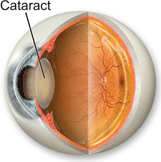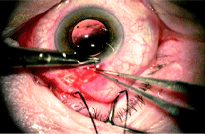Dr. Robert Mason - N-Acetyl-Carnosine (Nu-Eyes™) Eye Drops - The Cure For Cataract?
A Doctor's Point of View
Robert Mason, PhD - International Guide to Anti-Aging Drugs
NOTE: This article is provided with the expressed permission of IAS and is under full copy write protection of Dr. Robert Mason.
In the East and particularly in Russia over the last several years, they have been researching a special analogue of the di-peptide carnosine. This particular form is known as N-acetylcarnosine or NAC and it has been proven to be highly efficacious in the treatment of cataract and may also present a case for the prevention of the same. This article is about the case for NAC and the problems associated with senile-cataract.

Cataract is the leading cause of blindness and accounts for about 42% of all such cases worldwide, and this is in-spite of the availability of effective surgical treatment. Today we have the appalling situation where more than 17 million people around the world are blind because of cataract and 28,000 new cases are reported everyday. In developing countries, there is simply not a sufficient number of surgeons to perform cataract operations.
Cataract surgery is the most commonly performed surgical procedure in people over 65-years of age, and 43% of all visits to ophthalmologists by Medicare patients in the US are directly associated with cataract.
Meanwhile, approximately 25% of the population over 65 (and about 50% over 80) has a serious loss of vision due to cataract. Since this is the population that is most susceptible to lens opacification and as this section of the population is expected to increase dramatically, the numbers of individuals with cataract is set to explode!
For example, the World Health Organization anticipates that within the next 25-years, that 20% of the population will be 65 or older. Furthermore, the single largest growing section of the population are those over 85 and their actual numbers are expected to quadruple in about the same period. Such a rapidly burgeoning older population can only increase the numbers of individuals suffering from cataract.
Of course, there is also the economic impact. Currently 1.35 million cataract operations are performed annually in the United States alone and Medicare estimates the annual cost at $3.5 billion! There's no doubt about it cataract is a major disease. It is also becoming apparent that it will not be possible to eliminate the overall problems (including blindness), caused by cataract with the current procedures. With so many people presenting the afflictions of maturity onset cataract, it appears not to be possible to train in-time, the necessary numbers of surgeons required. In-fact, as-it-stands, it looks likely that the total number of people with serious eye-disorders because of cataract, will increase dramatically worldwide.
Surgical Complications Rarely Discussed...

There is another aspect to the problem that is rarely discussed. While cataract surgery is generally recognized as being one of the safest operations, there is a significant complication rate. For example, in the United States 30% to 50% of all patients having cataract extraction, develop opacification of the posterior lens capsule within two years and require further laser treatment.
Since the number of cataract operations is so large, even a small percentage of complications represent a significant number of people. Of the patients having cataract surgery, 0.8% have retinal detachments, 0.6% to 1.3% are hospitalized for corneal edema (or require corneal transplantation), and 0.1% present endophthalmitis. Thus, aside from secondary cataract, about 2% of the 1.35 million (or approximately 27,000 individuals), just in the US each year, develop serious complications as a result of cataract surgery.
It is therefore difficult to support the argument that cataract research is unimportant with statistics such as those cited above. The large and growing number of people blind with cataract and the significant complication rate, should be sufficient reason to increase cataract research.
The considerable discomfort experienced by patients as their vision diminishes, and the complete loss of accommodation resulting in the removal of the lens should also be recognized. Besides the possible complications, an artificial lens just does not have the overall optical qualities of a natural lens.
A medical solution is required that will maintain the transparency of the lens. Even if the development of cataract can be delayed by 10-years, the overall benefits would be highly significant.




